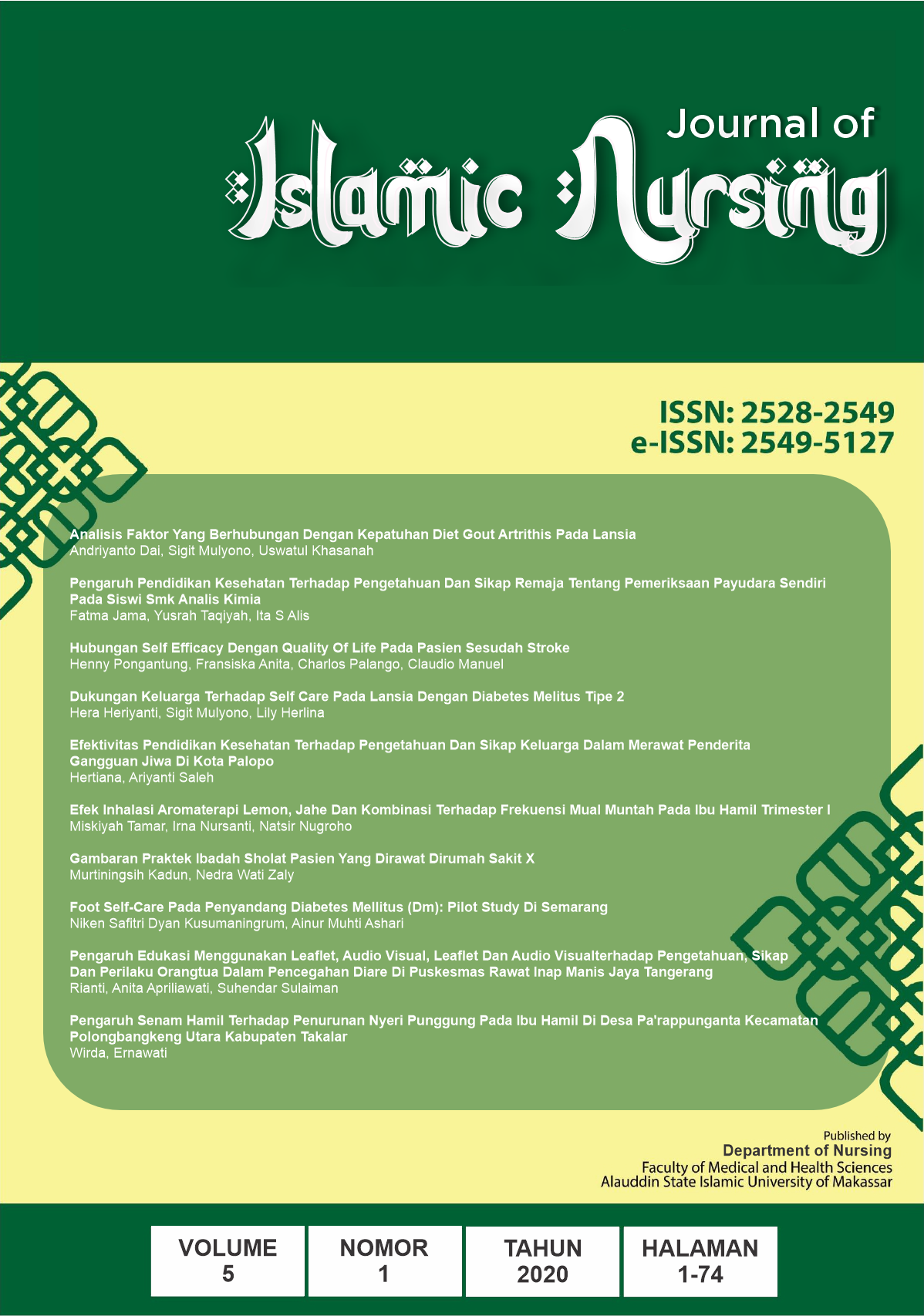FOOT SELF-CARE PADA PENYANDANG DIABETES MELLITUS (DM): PILOT STUDY DI SEMARANG
Abstract
Diabetes Mellitus is chronic metabolic disease that has the characteristics hyperglikemia due to insulin deficiency and lead to diabetic foot ulcers. That complications can be prevented by performing foot self-care. The purpose of this study was to identify foot self-care in persons with diabetes mellitus in Puskesmas Rowosari Semarang. This study was a quantitative research with cross sectional approach. The sampling technique used was consecutive sampling. Diabetic Foot Self-care Questionnaire University of Malaga was used to gather the data from diabetic. Analysis of the data used were univariate which produces tables. A total of 112 diabetic participated in the study. The majority patient participated in this study were they who age range 41-60 (69,6%), female (78,6%), did not have the experience to get education (50%), and suffering from diabetes <10 years(80,4%). The result of this study showed that 52.7% of diabetic have a good category on foot self care. In conclusion, more diabetic have good foot self-care. Therefore, it is needed to give more information for patients with diabetes in order to apply the foot self-care especially the examination of the feet, using lotion, socks, and the way to get the feet warm.
Downloads
References
Aprilyasari, R. W. (2015) ‘Hubungan lama menderita DM dengan perilaku perawatan kaki secara mandiri untuk mencegah ulkus diabetikum’, Jurnal Keperawatan dan Kesehatan Masyarakat, 2(3), pp. 29–35.
Bulechek, G. M. et al. (2013) Nursing interventions classification (NIC). 6th edn. United Stated of America: Elsevier Ltd.
Cavanagh, P. R. et al. (2005) ‘Treatment for diabetic foot ulcers’, 366, pp. 1725–1735.
Chand, G. et al. (2012) ‘Clinical queries : nephrology diabetic foot’, Clinical Queries Nephrology. Reed Elsevier India Pvt. Ltd, 1(2), pp. 144–150. doi: 10.1016/S2211-9477(12)70009-2.
Cho, N. H. et al. (2017) IDF Diabetes Atlas. Eight edit, IDF Diabetes Atlas, 8th edition. Eight edit. doi: http://dx.doi. org/10.1016/S0140-6736(16)31679-8.
Cho, N. H. et al. (2018) ‘IDF Diabetes Atlas: Global estimates of diabetes prevalence for 2017 and projections for 2045’, Diabetes Research and Clinical Practice. Elsevier B.V., 138, pp. 271–281. doi: 10.1016/j.diabres.2018.02.023.
Dewi, N. K. (2017) ‘Hubungan antara foot self-care dan neuropati perifer pada diabetisi’, skripsi, p. 77.
Dikeukwu, R. and Omole, O. (2013) ‘Awareness and practices of foot self-care in patients with diabetes at Dr Yusuf Dadoo District Hospital, Johannesburg’, Journal of Endocrinology, Metabolism and Diabetes of South Africa, 18(2), pp. 112–118. doi: 10.1080/22201009.2013.10872314.
Embil, J. M. et al. (2018) ‘Foot Care’, Canadian Journal of Diabetes. Elsevier Inc., 42, pp. 222–227. doi: 10.1016/j.jcjd.2017.10.020.
Funahashi, T., Shimomura, I. and Shimizu, Y. (2011) ‘Beneficial effects of foot care nursing for people with diabetes mellitus: An uncontrolled before and after intervention study’, Journal of Advanced Nursing, 9, pp. 1952–1962. doi: 10.1111/j.1365-2648.2011.05640.x.
Hanif, E. A. and Kusumaningrum, N. S. D. (2015) Foot self-care pada pasien dengan diabetes melitus di RSUD Kraton Pekalongan, skripsi. Universitas Diponegoro. Available at: http://eprints.undip.ac.id/49442/.
Hidayat, R. A. and Nurhayati, I. (2014) ‘Perawatan kaki pada penderita diabetes militus di rumah’, Jurnal Permata Indonesia, 5(2), pp. 49–54.
Li, R. et al. (2014) ‘The current status of foot self-care knowledge, behaviours, and analysis of influencing factors in patients with type 2 diabetes mellitus in China’, International Journal of Nursing Sciences, 1(3), pp. 266–271. doi: 10.1016/j.ijnss.2014.05.023.
Navarro-Flores, E. et al. (2014) ‘Development, validation and psychometric analysis of the diabetic foot self-care questionnaire of the University of Malaga, Spain (DFSQ-UMA).’, Journal of tissue viability. doi: 10.1016/j.jtv.2014.11.001.
Odhayani, A., Tayel, S. and Al-madi, F. (2016) ‘Foot care practices of diabetic patients in Saudi Arabia’, Saudi Journal of Biological Sciences. King Saud University, 24(7), pp. 1667–1671. doi: 10.1016/j.sjbs.2015.12.003.
Sheila, M. et al. (2016) ‘Foot care behaviors among adults with Type 2 diabetes’, Primary Care Diabetes. Primary Care Diabetes Europe, 6(10), pp. 442-451. doi: 10.1016/j.pcd.2016.04.002.
Smeltzer, S. C. and Bare, B. G. (2013) Buku ajar keperawatan medikal bedah Brunner & Suddarth. 8th edn. Jakarta: EGC.


